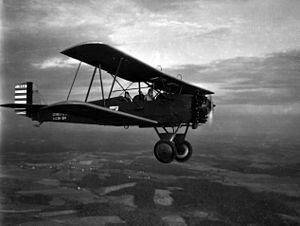Top speed 190 km/h Length 8.51 m Manufacturer Consolidated Aircraft | Wingspan 10 m First flight April 1927 | |
 | ||
Short clip of an rcaf consolidated o 17 courier as a float plane at jericho circa 1930
The Consolidated Model 2 Courier was an observation and training airplane used by the United States National Guard, under the designation O-17.
Contents
- Short clip of an rcaf consolidated o 17 courier as a float plane at jericho circa 1930
- Development
- Variants
- Operators
- Specifications O 17
- References
Development
A parallel development to the PT-3 series, the XO-17 was a converted PT-3 with such refinements as improved fuselage streamlining, oleo shock absorbers, wheel brakes, balanced elevators and increased fuel capacity.
It was used almost exclusively as a cross-country flying, gunnery, photographic and radio trainer. The O-17 had a removable fairing (carrying a Scarff ring mounting for one .30 cal (7.62 mm) trainable Browning machine gun.
The Royal Canadian Air Force purchased three generally similar aircraft, two Model 7 landplanes and one Model 8 floatplane, the latter with the same float gear as the NY series.
The sole XO-17A was converted from the PT-3 as a demonstrator that failed to secure any orders. It was later fitted with the experimental Packard DR-980 Diesel engine of 225 hp (168 kW).
The Model 15 was also an O-17 type airframe fitted with a Pratt & Whitney R-1340 engine. It too failed to win any contracts.
Variants
Operators
Specifications (O-17)
Data from Eden & Moeng (2002)
General characteristics
Performance
Armament
